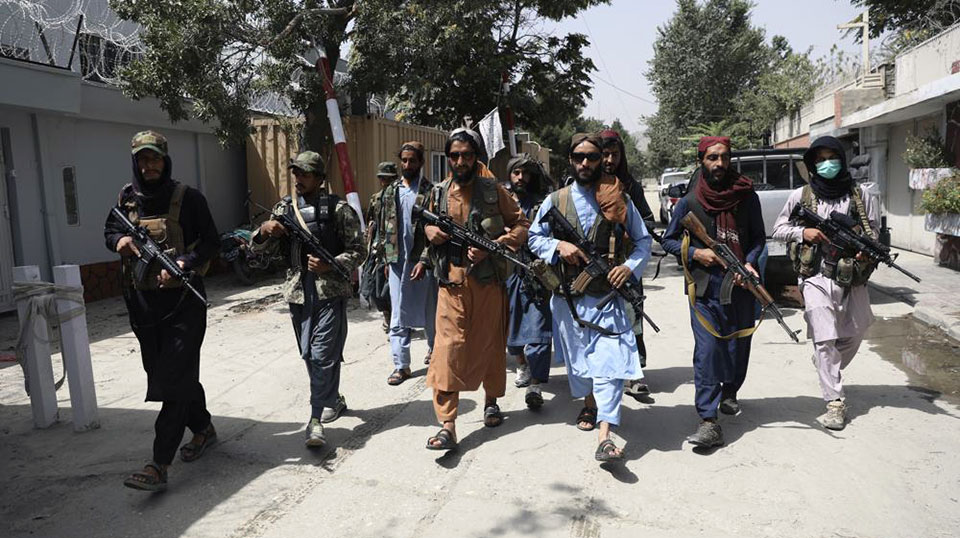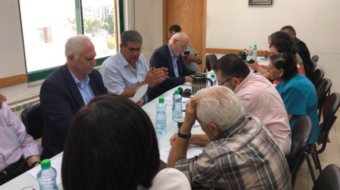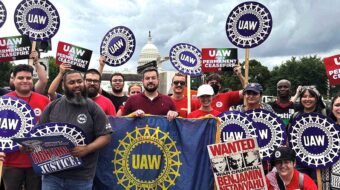
The following interview is with an activist described as “a comrade of the Left from Afghanistan” whose name, for safety reasons, was withheld from publication. It first appeared in the Communist Party of Britain’s International Bulletin. It has been edited for clarity and length. Some of the questions concern the “current government of Afghanistan”—a government that ceased to exist as of this past weekend when the Taliban retook control of the capital.
How would you characterize the current Afghan government?
The government is a puppet, they depend entirely on the will of the U.S., they have no margin of activity in interior and exterior politics. Everything it does depends on the U.S. Until now all measures are led by the U.S. The government has no independent will concerning the regulation of questions for the country.
Whenever there are problems, such as during elections, the U.S. creates solutions outside the constitution. For example, in 2014 there was such a big gap between two presidential candidates that it took too long to declare the winner. U.S. Secretary of State John Kerry came to Afghanistan to create a solution—a government of national unity. This does not exist in the Afghan constitution! When we have big national problems, we ourselves have no power or competence sufficient to resolve them; the Americans always come in to solve things.
In the last elections, the same problem arose. Both candidates wanted to be president, but the Americans decided that Ashraf Ghani would be president, and they created a new post to allow the other candidate to have a government position. All of this was illegal, outside of the constitution.
How strong are the organized working-class movement, the trade unions, and progressive political parties?
It’s a very complicated situation at the moment. We (the People’s Democratic Party of Afghanistan) were in power in the 1980s. That government was followed by an arbitrary and despotic regime, resulting in a totally chaotic situation. They swept away all progressive movements, chased all the popular movements out of power—and even out of the country.
We were smashed and split into a thousand pieces, and in our place, there were fractional wars between Mujahideen, tribal groups, and warlords. There were 70,000 dead. There was no place for normal political life, strikes, elections, or any of this. There was no space for political organizations.
This situation lasted for years until 2001 when there was an opportunity for the Americans to occupy Afghanistan.
When the Americans occupied, a new order was formed. They set in motion the process of creating a government. This government was formed by old administrators trained by the CIA and reactionary elements, so there was still no chance of popular entry to this government of occupation.
They created a fake democracy, full of limits and all designed to keep the ruling elite in power. There was no opportunity for the left to participate or express itself. No possibility to gain terrain. The U.S. allowed political parties to form, legally, but they could not organize on the ground in a situation of war.
Along with this, there is always outside pressure on and threats against progressive parties. There is technically a right to strike, but in reality, there are no big organized strikes. There is the right to a free press, but no actual conditions to express it. This was a deliberate effort by the Americans; they did not want any left organizations, no popular forces in the country.
According to (previous Afghan President) Ghani, 90% of Afghans live under the poverty line. It was not like that when we (the PDPA) were in power! This low level of development is difficult for trade unions, there are real problems of hunger in some parts of the country.
What are the reasons for the U.S./NATO withdrawal?
It is not really a retreat, and I will explain why. The military bases are all still there, they are still maintained. The country is still occupied whether or not you have soldiers there. The Americans have created a policy which ensures they will still control the country:
- They have created a social base dependent on U.S. capital. Essentially this is the old Mujahideen and pro-U.S. administrators. This social base consumes the majority of U.S. aid and holds the country’s wealth. There are different fractions, people who have contracts for construction, logistics, petrol. There is lots of money flowing into specific social groups. For example, Bagram airbase needs petrol, a lot of petrol! This is contracted to a private business, with wide profits shared among the layer of pro-U.S. social elites. This group will do everything it can to defend the USA and its interests.
- As mentioned earlier, there was a system of administration created which prevents the emergence of national or progressive forces.
- There is a military pillar, a security force which does what the Americans say.
So the soldiers go, but the whole system of occupation has not gone.
The Taliban was created by the British government, organized by the Pakistani government, and funded by Saudi Arabia. The Taliban are a creation (as in–they have been constructed). The Mujahideen covered eight different groups operating out of Pakistan during the 1980s; they were many disparate dispersed groups, not easily controlled by the U.S.
They were allies with the U.S. against socialism, but they pursued an independent policy. When the Taliban were made, they did exactly what the Pakistanis told them. When they were in power, they were very friendly with the U.S.; they talked, they had business negotiations on gas deals, and they committed the very worst atrocities.
There was terrible violence, huge massacres against the poorest ethnic groups. Killing people by putting them in cages in the desert without food or water. They organized mass killings; 62% of the Azarak population was killed. The Taliban blew up an ancient Buddha statue, no respect for cultural heritage. The U.S. allowed this to continue without doing anything.
The Taliban was never anti-U.S. overall, but they were unreliable. Afghanistan was a strategic location, and the U.S. wanted more direct control there. So understand that the U.S. wanted to invade because it was in their geopolitical interests; 9/11 and all the war on terror was a pretext.
What might be the consequences of a politicized Islamic regime in Kabul for the stability of Central Asia, the Indian subcontinent, and China’s Belt and Road Initiative?
Well, there is already an Islamist government in Afghanistan; the Americans like this. They created it in 2001! They want a country like Saudi Arabia, or Morocco, this is the wish of the Americans. The regional issue can be seen through manipulation of ethnicities. The Taliban are mostly Pashtun (in the southeast of the country), and not a majority, although we can’t be sure because there is no proper census.
To understand the regional dimension, it is enough to say that the war started in the east of the country and was transferred to the north of the country. The Americans deliberately shifted the conflict and pushed it to the borders of Russia, China, and Tajikistan. This process of movement was important to make it an international problem.
In one month, the Taliban took 60 cities in the north (provinces of Badakhshan, Kunduz), all areas where there are Uzbeks, Tajiks, and Azraks, but no Pashtuns. How is it the Taliban could take the cities without local support? The Taliban are a conquering force in the north. The U.S. seeks to weaponize the Taliban against Tajikistan (a secular and pro-Russian country) and against China. The U.S. seeks to use the Taliban in this way, to threaten and destabilize Central Asia.
The Collective Security Treaty Organization was formed specifically to stop the Taliban from spreading into Central Asia. It includes Russia, Armenia, Belarus, Kazakhstan, Kyrgyzstan, and Tajikistan. The Russians have very strong military bases in Tajikistan, with all the latest technology. They brought Iskander missiles there. Why would they bring these big rockets for little Taliban fighters? The missiles are there to guard against the Americans, against NATO bases, because the Russians understand it is NATO pushing the Taliban into Central Asia.
The Chinese wanted to put the New Silk Road through Afghanistan, and historically Afghanistan was a big part of the Silk Road. These trade routes would help the Chinese, and they would help develop Afghanistan, but the Americans said no, they stopped it. There is an open-cast copper mine in Afghanistan, a huge mine, the second biggest in the world, created by the PDPA government.
The Chinese offered to buy the mine for $2 million; they signed a contract in the early 2000s. Chinese investment would have created jobs, developed the economy. The Americans said no, they told the Chinese to leave. The U.S. wants to block the Silk Road, and they aren’t interested in projects for economic development.











Comments